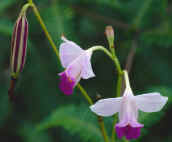|
|
|
|||||
|
|
||||||
|
||||||||||
|
Fast Growing Trees Fastest
Deciduous |
|
Faster
Deciduous |
|
Fast
Deciduous
Evergreen |
|
Fast Growing
Hedging Plants
Deciduous
Evergreen
Arborvitae
Douglas Fir |
 |
Over the
Fence
|
| This page Flowers Seeds Pests and disease Plants Vegetables Miscellaneous |
|
Connected pages Plants | Animals / critters / pests | Hints and tips | The bigger picture |
Flowers
![]() Azaleas
like a bit of white wine vinegar added to their water every so often. They also
like used teabags as fertilizer.
Azaleas
like a bit of white wine vinegar added to their water every so often. They also
like used teabags as fertilizer.

![]() Orchids in the house.
Two of the easiest for the home without needing special accommodation;
Orchids in the house.
Two of the easiest for the home without needing special accommodation;
1 - Phalaenopsis - Moth Orchid. This easily grown orchid produces sprays of large moth shaped blooms that last for months. Choose a window facing east or west for bright light without direct sunlight. Water regularly and avoid letting the potting mix dry out. Apply a balanced fertilizer at half the recommended rate every couple of weeks. Repot the orchid every one or two years making sure the pot is large enough to accommodate the root mass.
2 - Paphiopedilums - Lady's Slipper Orchid. This orchid is another good choice because they grow well under shady conditions. A window facing east or west will provide the best light. These plants should remain moist and should be watered once or twice a week. Fertilize like the moth orchid using a balanced fertilizer at half the recommended rate every two weeks. Repot the orchid when the mix decomposes, probably every two years or so.
![]() Sweet
Peas. Pinch off
the tendrils to improve the flowering capacity .
Sweet
Peas. Pinch off
the tendrils to improve the flowering capacity .
Seeds

![]() When sowing
seeds, as a rule of thumb bury them the depth of their own diameter. Mix
fine seeds with sand for easier sowing to ensure they are spread evenly over
the compost surface.
When sowing
seeds, as a rule of thumb bury them the depth of their own diameter. Mix
fine seeds with sand for easier sowing to ensure they are spread evenly over
the compost surface.
![]() Always
sow seeds in new seed compost, don't try to make do with ordinary potting
compost even if it says it's ok on the bag. Trials show that seeds germinate
best in seed compost (surprise!) and trying to cut the cost by using what
you've got will almost always turn out to be a shot in the foot when some seeds
germinate poorly or not at all.
Always
sow seeds in new seed compost, don't try to make do with ordinary potting
compost even if it says it's ok on the bag. Trials show that seeds germinate
best in seed compost (surprise!) and trying to cut the cost by using what
you've got will almost always turn out to be a shot in the foot when some seeds
germinate poorly or not at all.
Pests and disease
![]() Elder spray.
This kills aphids, small caterpillars and is useful as a fungicide for mildew
and blackspot on roses. The toxic agent is hydro-cyanic acid, so in preparing
the spray use an old saucepan.
Elder spray.
This kills aphids, small caterpillars and is useful as a fungicide for mildew
and blackspot on roses. The toxic agent is hydro-cyanic acid, so in preparing
the spray use an old saucepan.
Gather 450g (1 lb) leaves and young stems of elder prefer-ably in spring when
the sap is rising. Place in the saucepan and add 3.3 litres (6pt) water. Boil
for half an hour, topping up as necessary. Strain through old tights and use
the liquid cold and undiluted. It will keep for three months if bottled tightly
while still hot.

![]() Slugs
and Snails (again
- the problem lasts forever.....) Another possible way of keeping slugs
away from sensitive plants sprinkle eggshells around them. Ash and grit are
also supposed to be effective. Sprinkle slugs with salt to kill them (if you
can stand the resulting agony). It is also possible to trap slugs using containers
in the ground that have some beer in the bottom, though you still have to get
rid of them which is a problem if you don't hate your neighbor.
Slugs
and Snails (again
- the problem lasts forever.....) Another possible way of keeping slugs
away from sensitive plants sprinkle eggshells around them. Ash and grit are
also supposed to be effective. Sprinkle slugs with salt to kill them (if you
can stand the resulting agony). It is also possible to trap slugs using containers
in the ground that have some beer in the bottom, though you still have to get
rid of them which is a problem if you don't hate your neighbor.
Empty grapefruit halves work as well. Petroleum jelly smeared around plant pots stops slugs getting to the plants inside. Personally I have to admit to being a fan of slug pellets. They're very effective, ideal for the coward (like me) as you don't see the dead or dying slug/snail and not much effort. Go for the smallest pellets and ignore claims of "rainproof" - it usually just means "bigger and so take (marginally) longer to disintegrate". Scatter them evenly so they land a couple of inches apart, mounds don't work - the molluscs can't see them and don't know that they're supposed to go there to eat them.
 Another
way to deal with your captured slugs and snails (though I haven't tried it myself)
is to put them in a plastic Tupperware type container and then put them in the
freezer. This is probably the most humane way as they just slow down and become
torpid in the cold being cold blooded (yes they do have blood of sorts). So
they are effectively anaesthetised before being frozen.
Another
way to deal with your captured slugs and snails (though I haven't tried it myself)
is to put them in a plastic Tupperware type container and then put them in the
freezer. This is probably the most humane way as they just slow down and become
torpid in the cold being cold blooded (yes they do have blood of sorts). So
they are effectively anaesthetised before being frozen.
![]() Nettle spray.
The common stinging nettle is a discerning plant that requires high levels of
nitrogen in the soil to grow well, using the leaves in sprays of several kinds.
As well as using nettles as an activator on the compost heap the organic gardener
can use them as a liquid manure and as an aphicide - to kill aphids (greenfly).
Nettle spray.
The common stinging nettle is a discerning plant that requires high levels of
nitrogen in the soil to grow well, using the leaves in sprays of several kinds.
As well as using nettles as an activator on the compost heap the organic gardener
can use them as a liquid manure and as an aphicide - to kill aphids (greenfly).
Gather 224g (l/21b) young nettles and soak in a bucket of water for a week.
Strain and use undiluted as a control of aphids on roses and celery leaf miner.
Add the mushy nettles to the compost heap.
![]() Rhubarb spray. The
oxalic acid in rhubarb leaves is a safe control agent for aphids, particularly
those on roses. Cut 450g (1lb) rhubarb leaves, place in an old saucepan (the
oxalic acid may damage one that you still use) with 1.1 litres (2pt) water and
boil for half an hour, topping up as necessary. When cool, add 1 dessertspoon
of soap flakes dissolved in 275ml (1/2pt) warm water. This acts as the wetting
agent when added to the strained rhubarb liquid. Stir the mixture thoroughly
and use undiluted as a spray.
Rhubarb spray. The
oxalic acid in rhubarb leaves is a safe control agent for aphids, particularly
those on roses. Cut 450g (1lb) rhubarb leaves, place in an old saucepan (the
oxalic acid may damage one that you still use) with 1.1 litres (2pt) water and
boil for half an hour, topping up as necessary. When cool, add 1 dessertspoon
of soap flakes dissolved in 275ml (1/2pt) warm water. This acts as the wetting
agent when added to the strained rhubarb liquid. Stir the mixture thoroughly
and use undiluted as a spray.

![]() Avoiding whitefly on tomatoes without the use of chemicals.
Plant French Marigolds (Tagetes) between your tomato plants to keep those pesky
Whitefly away. It's not that the Whitefly particularly don't like these marigolds,
it's because the pungent smell from the marigolds masks the nice smell of the
tomatoes that usually attract the Whitefly.
Avoiding whitefly on tomatoes without the use of chemicals.
Plant French Marigolds (Tagetes) between your tomato plants to keep those pesky
Whitefly away. It's not that the Whitefly particularly don't like these marigolds,
it's because the pungent smell from the marigolds masks the nice smell of the
tomatoes that usually attract the Whitefly.
![]() Selecting
Plants. When buying herbaceous plants, including
bedding, resist choosing just because they are in flower. Look at the overall
plant and condition of the roots. Choose a plant full of buds in preference
to one in full flower.
Selecting
Plants. When buying herbaceous plants, including
bedding, resist choosing just because they are in flower. Look at the overall
plant and condition of the roots. Choose a plant full of buds in preference
to one in full flower.
![]() Leaves.
The most likely cause of older plant leaves dropping
is under-watering whereas the most likely cause of younger plant leaves going
yellow is over-watering.
Leaves.
The most likely cause of older plant leaves dropping
is under-watering whereas the most likely cause of younger plant leaves going
yellow is over-watering.
![]() Weeds.
Applying a teaspoonful of salt can individually kill
a weed such as dandelion in your lawn.
Weeds.
Applying a teaspoonful of salt can individually kill
a weed such as dandelion in your lawn.
![]() Houseplants.
To stop a windowsill houseplant becoming lopsided
keep turning and moving it every couple of days.
Houseplants.
To stop a windowsill houseplant becoming lopsided
keep turning and moving it every couple of days.
![]() If you have any hardy container plants
that you have propagated and intend to plant them out in the garden, then early
spring is a good time to pot them on into larger pots. Add about 25% by
volume of sharp sand or fine gravel to the mix to help drainage. Spring tends
to be wet and compost alone can get very soggy and overgrown with liverworts.
The sand and gravel also encourage a greater extent of roots that will stand
the plants in good stead later on. By early to mid summer they will need either
planting out or potting on again, this time into 100% compost.
If you have any hardy container plants
that you have propagated and intend to plant them out in the garden, then early
spring is a good time to pot them on into larger pots. Add about 25% by
volume of sharp sand or fine gravel to the mix to help drainage. Spring tends
to be wet and compost alone can get very soggy and overgrown with liverworts.
The sand and gravel also encourage a greater extent of roots that will stand
the plants in good stead later on. By early to mid summer they will need either
planting out or potting on again, this time into 100% compost.
Vegetables
![]() Tomatoes grown in slightly
salty water have been shown to taste sweeter. A teaspoonful in two gallons
is supposed to have the desired effect. (though I would only do it the once
rather than every time you water!).
Tomatoes grown in slightly
salty water have been shown to taste sweeter. A teaspoonful in two gallons
is supposed to have the desired effect. (though I would only do it the once
rather than every time you water!).
Make sure you water tomatoes regularly. Any stop - go in the watering regimen can cause the skins to split when the fruit swells rapidly with extra water after hardening up when there wasn't much available.
![]() Celery (raw) is negative calories.
It takes more calories to eat and digest raw celery
than you can get from the celery itself (Wood and cardboard is similar.).
Celery (raw) is negative calories.
It takes more calories to eat and digest raw celery
than you can get from the celery itself (Wood and cardboard is similar.).
Miscellaneous

![]() Quick-cleaning
a barbecue.
Pour leftover coffee on the grill. Clean off with a dry cloth. For a really
good clean, spray the grill with your regular oven cleaner and leave it in a
plastic rubbish bag overnight. Hose it down the next day, and you should have
a gleaming grill.
Quick-cleaning
a barbecue.
Pour leftover coffee on the grill. Clean off with a dry cloth. For a really
good clean, spray the grill with your regular oven cleaner and leave it in a
plastic rubbish bag overnight. Hose it down the next day, and you should have
a gleaming grill.
![]() BBQ Care And Cleaning.
For a quick way to clean your barbecue grill, simply rub the grill in sand.
This will remove most of the grease, etc. All you then have to do is hose it
down!
BBQ Care And Cleaning.
For a quick way to clean your barbecue grill, simply rub the grill in sand.
This will remove most of the grease, etc. All you then have to do is hose it
down!
![]() Plastic furniture.
If your plastic garden furniture
gets stained, make a paste by mixing of baking soda and water and apply it for
a few minutes before wiping it off
Plastic furniture.
If your plastic garden furniture
gets stained, make a paste by mixing of baking soda and water and apply it for
a few minutes before wiping it off
![]() Frost.
To protect sensitive seedlings from late frosts cover with miniature greenhouses,
made from plastic drink bottles with the bottoms cut off and placed around each
seedling. Large drinking water bottles are particularly good for larger plants.
Frost.
To protect sensitive seedlings from late frosts cover with miniature greenhouses,
made from plastic drink bottles with the bottoms cut off and placed around each
seedling. Large drinking water bottles are particularly good for larger plants.
![]() Plastic bottles.
Take a 1.5Ltr or 2Ltr clear plastic bottle and cut off the base with scissors.
Remove the stopper and place over a single plant. A simple but effective way
of protecting tender plants from slugs or the weather.
Plastic bottles.
Take a 1.5Ltr or 2Ltr clear plastic bottle and cut off the base with scissors.
Remove the stopper and place over a single plant. A simple but effective way
of protecting tender plants from slugs or the weather.
|
|
|
About us. General queries and emails to |
|
Copyright © Paul Ward 2000 - 2012 |